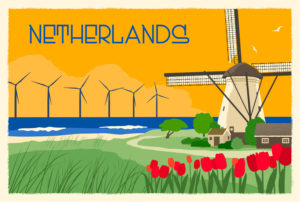China could become a trail-blazing country for science-based nature protection with its ecological redlines initiative. Primarily designed to restore wildlife and protect the benefits people receive from nature, policy researchers are now also looking at the initiative’s potential to boost carbon sequestration and so mitigate climate change.
One practical way to start aligning nature and climate targets in this way would be for China to make the ecological redline initiative part of its next five-year plan under the Paris Agreement on climate change, or Nationally Determined Contribution (NDC), which the country is due to announce shortly.
Scientists and policymakers widely accept that a much larger share of the planet needs to be protected for biodiversity. Recent research suggests that 30% to 70% of the planet’s surface needs protection if biodiversity is to conserved effectively. International negotiations under the Convention on Biological Diversity (CBD), due to conclude next year at a summit in Kunming, China, are moving towards a target of 30% by 2030.
Continuing nature loss globally shows that the existing approach to conservation, based on protected areas, is insufficient. In response, China has developed its system of “ecological conservation redlines”. This important innovation is in the process of being implemented. The redlines can contribute to the reversing of ecological degradation and biodiversity loss, as well as to climate change mitigation and adaptation.
How are redlines different from protected areas?
China’s ecological redline policy is an improvement on its system for protected areas in several ways.
First, and critically, the selection of redline areas is thoroughly science-based. The decision on which areas or habitats to protect is based on a technical assessment of the benefits to both nature and people. These benefits were carefully mapped, based on three criteria: biodiversity, ecosystem services (such as ensuring the availability of fresh water and healthy soils), and disaster risk reduction (such as coastal defence, flood protection, landslides, sand storms, etc).
This integrated approach, assessing overall benefits, provides a stronger rationale for protection, bringing more of the key affected communities and organisations on board. As a result of such assessments, the redlines include thousands of areas, of all shapes and sizes, near sparsely as well as heavily populated areas, in a wide array of biomes.
Second, the scheme protects all key species and habitats, as defined in the Chinese government document “Ecological Conservation Redlines Delineation Guidance” (MEE and NDRC, May 2017). While China has previously established various types of protected areas, covering about 18% of its land area, this has still left valuable ecosystems, plants and animals unprotected. The ecological redline areas have been drawn with precision to protect the habitats of all rare and endangered animals and plants. With a “top-down” design, the system enables decision-makers to manage the entire landscape holistically, and in a unified way. This greatly benefits the integrity and connectivity of habitats.
Third, by going beyond flagship areas such as national parks, the scheme protects more nature. It provides a creative solution to biodiversity protection. The international community has reached a consensus on addressing biodiversity loss using nature reserves and “other effective conservation measures”. However, relying solely on the establishment of protected areas falls well short of what science tells us is needed. The ecological conservation redline system provides a new approach to achieve large-scale and holistic protection of species and habitats.
This is shifting the culture of “start construction before all permits are obtained”, which has been all too common in China
Fourth, we expect strict enforcement, aided by top-down management, satellite intelligence and systems to facilitate public supervision. Inside redline areas, all types of development and construction activities that have a significant impact will be banned: only very limited, low-intensity human activities will be allowed, for example for local communities. Regarding enforcement, redline areas benefit from regular inspections that force local governments to take note. For example, an offshore airport that began being built near Sanya in Hainan was halted when a disciplinary inspection revealed it was inside an ecological redline area, and lacked proper permits. This is shifting the culture of “start construction before all permits are obtained”, which has been all too common in China and has led to uncontrolled development.
The history of China’s ecological redlines
The ecological redlines were first proposed in 2011, and subsequently enshrined in the Environmental Protection Law of 2015. In 2017, the Chinese government issued the “Opinions on Delineation and Strict Management of Ecological Conservation Redlines” to implement the redline policy for ecological conservation nationwide.
In October, the government took an important further step when it issued the draft “Ecological Redline Implementing Regulation” for public comments. The ecological redlines have largely been drawn, giving legal protection to at least 25% of the country’s land and sea area, but the full map is yet to be publicly disclosed.
President Xi Jinping has repeatedly emphasised his commitment to the system. Last month, at the Fifth Plenary Session of the 19th Central Committee of the Communist Party of China, China once again confirmed “improving the regulatory system for nature reserves and the ecological redlines” as a priority.
Conservation and climate action
By including habitats such as forests and grasslands the redlines initiative will also benefit climate action.
Plants and soils can sequester significant amounts of carbon dioxide, complementing efforts to cut carbon emissions from power generation, industry, transportation, etc. These habitats can also provide valuable climate adaptation benefits, for example for flood and drought control. Forests are important participants in the water cycle, helping ensure local rainfall. They also consolidate slopes, preventing land slides and soil erosion. They also benefit the resilience of food production, by ensuring that key ecosystems continue to provide insects for pollination, for instance.
While countries can and should take conservation steps that suit their own context, much can be learnt from China’s ecological redlines. Taking a scientific approach to spatial mapping is particularly relevant. We expect that China’s approach to implementation and enforcement will also be innovative, with lessons and experiences for others. One practical, ready way for China to share its ecological redline experience could be through its Belt and Road Initiative, making infrastructure investment conditional on host countries taking a similar approach to conservation.
Britain and China, as hosts of significant UN climate and biodiversity summits next year, called COP26 and COP15 under the UNFCCC and CBD respectively, are eager to identify opportunities to link nature and climate action and align the global response to both challenges. The environmental community has long advocated for such a harmonised approach. The ecological redline system is an excellent example of a nature-based solution to both climate and nature that could do just that.








